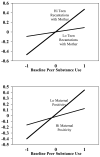Predictors of susceptibility to peer influence regarding substance use in adolescence
- PMID: 22188526
- PMCID: PMC3390749
- DOI: 10.1111/j.1467-8624.2011.01682.x
Predictors of susceptibility to peer influence regarding substance use in adolescence
Abstract
The extent to which peer influences on substance use in adolescence systematically vary in strength based on qualities of the adolescent and his or her close friend was assessed in a study of 157 adolescents (age: M = 13.35, SD = 0.64), their close friends, and their parents assessed longitudinally with a combination of observational, analogue, sociometric, and self-report measures from early to mid adolescence. The degree to which adolescents changed their levels of substance use in accord with their peers' baseline levels of use was predicted by a range of theoretically salient factors including: observed teen lack of autonomy and social support in prior interactions with mothers, low teen refusal skills, and the level of social acceptance of their close friend. Findings suggest the importance of both internal factors (e.g., autonomy and relatedness struggles) and external factors (e.g., social status of friends) in explaining why vulnerability to peer influence processes may be much greater for some adolescents than others.
© 2011 The Authors. Child Development © 2011 Society for Research in Child Development, Inc.
Figures



References
-
- Adams RE, Bukowski WM, Bagwell C. Stability of aggression during early adolescence as moderated by reciprocated friendship status and friend's aggression. International Journal of Behavioral Development. 2005;29:139–145.
-
- Allen JP, Hall FD, Insabella GM, Land DJ, Marsh PA, Porter MR. Supportive Behavior Coding System. Charlottesville, VA: University of Virginia; 2001.
-
- Allen JP, Hauser ST, Bell KL, McElhaney KB, Tate DC, Insabella GM, et al. Unpublished manuscript. University of Virginia; Charlottesville, VA: 2000. The autonomy and relatedness coding system.
-
- Allen JP, Hauser ST, Bell KL, O'Connor TG. Longitudinal assessment of autonomy and relatedness in adolescent-family interactions as predictors of adolescent ego development and self-esteem. Child Development. 1994;65:179–194. - PubMed

